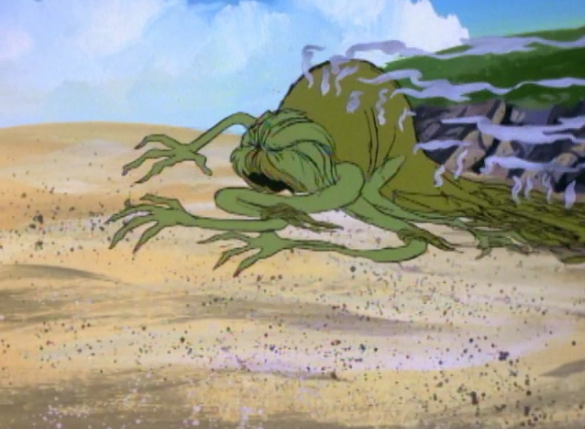This
week on Hanna-Barbera’s Godzilla (1978), the Calico travels
to the Sargasso Sea.
Carl
warns Quinn and Brock about getting tangled up in seaweed when they go for a
dive, noting that “these waters can be
dangerous.”
But
even he couldn’t have anticipated that beneath the waves a giant, malevolent sea
monster lurks.
The
giant monster below the ocean’s surface entangles the swimmers, but Godzooky
rescues them, and then barely escapes himself.
Godzilla is summoned by Godzooky’s cry, and the goliath defeats the
monster handily
But
before long, Quinn’s samples of sea-weed on the Calico begin growing as
well.
Quinn
determines that only the heat of sunlight can dry them up these monstrous
specimens and destroy the beasts.
Now
Godzilla must get the monsters to the heat of a nearby island to let the sun do
its job.
“The
Seaweed Monster” is a fun episode of Godzilla, though there are some
major gaps in logic here to consider too.
First,
sea-weed can be burned up by any number of means, and there is no reason to depend
solely on the light of the sun. Godzilla’s
atomic fire-breath is a perfectly adequate weapon, and indeed, he uses it in
the episode’s final frames to burn up one of the monsters.
This
is a solution that any fan of Godzilla (and any kid paying
attention…) would like hit upon almost immediately, so it’s baffling that it
takes Quinn and the others nearly twenty-two minutes to come up with it.
Secondly,
Godzilla must laboriously drag one of the Seaweed monsters -- on his back no
less -- to a nearby island, where the sun is apparently hotter. Now, I would understand this idea if the
island were far away, near the Arctic or Antarctic, for instance. But this island is within walking distance
for Godzilla. So is it really that much
hotter there that it would make a difference in terms of burning the creature
up?
Outside
these issues, there is a degree of tension in “The Seaweed Monster” that makes
it a lot of fun.
The
seaweed monster keeps adding mass, as more seaweed joins with it, and even
after dispersed, more seaweed can come together rejoin, and produce another
monster.
“Some instinct is making the seaweed assemble
into one giant mass,” a character notes, and that may not be a very good
scientific explanation, but it makes for an enemy that is harder to pin down,
and more difficult to permanently defeat.
The scenes in which the divers are pursued by the monster, and it grips
them with ever-more tendrils are actually pretty effective and suspenseful.
That fact established, you’ve just got to feel sorry for the last seaweed monster as it
crawls away, dried up in the sun, and is pursued by Godzilla. We don’t ever really learn why it is so
hostile, and it is kind of pathetic in this final form.
Maybe it just didn’t want its territory to be
invaded by humans…










No comments:
Post a Comment